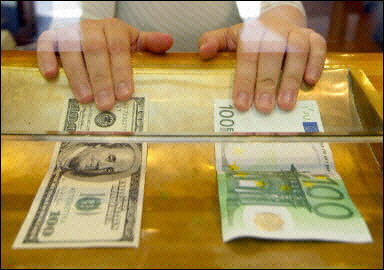The euro reached the lowest level in almost a year against the dollar as signs the region’s economy is under-performing that of the U.S. damped demand for the shared currency.
Hedge funds and other large speculators last week increased bets on declines in the euro versus the dollar to the most in more than two years. A report today is forecast by economists to confirm euro-area manufacturing expanded at a slower pace in August, adding to the case for the European Central Bank to expand stimulus. Sweden’s krona dropped to a more than two-year low versus the dollar after the pace of manufacturing growth slowed more last month than economists forecast.
“One of the big reasons why euro-dollar is going down is we’ve got talk of tightening coming out of the Federal Reserve and the opposite kind of talk coming out of Europe,” said Thomas Averill, a managing director in Sydney at Rochford Capital, a currency and rates risk-management company. “Data out of the U.S. has been pretty good.”
VIDEO: Swedish Krona Seen Weaker at 9.40 per Euro, Yu Says
The euro was little changed at $1.3130 as of 8:45 a.m. London time after earlier touching $1.3119, the weakest since Sept. 6. The euro has declined for the past seven weeks, the longest stretch since December 1999.
The 18-nation common currency was little changed at 136.74 yen, after falling 0.7 percent in August. The dollar rose less than 0.1 percent to 104.15 yen, after gaining 1.3 percent last month. U.S. markets are closed for the Labor Day holiday.
Bearish Bets
The difference in the number of wagers on a decline in the euro against the dollar compared with those on a gain — so-called net shorts — was 150,657 on Aug. 26, the most since July 2012, according to data from the Washington-based Commodity Futures Trading Commission.
VIDEO: Euro Seen Weaker at $1.32 By Year End, Sneyd Says
The euro may fall toward $1.30 this week and find support around that level, Rochford’s Averill said. Support is an area on a chart where there may be orders to buy.
The Markit Economics final August index of euro-area manufacturing was at 50.8 last month, the lowest level since July 2013 and in line with an earlier estimate, according to the median estimate of economists surveyed by Bloomberg News before the data today. Readings exceeding 50 indicate expansion.
The ECB will hold a policy meeting on Sept. 4. It may embark on quantitative easing this year or next, according to 44 percent of respondents in a Bloomberg survey last month.
VIDEO: Dollar Below 1.3350 Per Euro `Important’ for Rally
Draghi ‘Dovish’
“We expect ECB President Draghi’s statement to be scrutinized for hints regarding the thresholds for Quantitative Easing,” Mitul Kotecha, the Singapore-based head of Asia-Pacific foreign-exchange strategy at Barclays Plc, wrote in an e-mailed note to clients today. “Although Draghi will sound dovish, policy inaction may give the euro some limited, albeit short-lived, relief.”
The Citigroup Economic Surprise Index for the euro region dropped to minus 45.10 on Aug. 29, the lowest since June 2013. A negative number means data releases have been weaker than expected. The equivalent U.S. index was at 34.60, the most since Jan. 31.
The euro slid 1.6 percent in the past month, the worst performer among the Bloomberg Correlation-Weighted Indexes that track 10 developed-nation currencies. The dollar rose 0.9 percent, while the yen fell 0.8 percent.
VIDEO: Norway Krone Seen Stronger at 8 Per Euro on CPI
The Swedish krona declined against all of its 16 major peers after Swedbank in Stockholm said its manufacturing purchasing managers’ index fell to 51 in August from a revised 55.1 the previous month. The median estimate in a Bloomberg News survey of analysts was for a reading of 54.8.
The krona slid 0.3 percent to 7.0111 per dollar after reaching 7.0346, the weakest level since July 2012. It declined 0.3 percent to 9.2039 per euro.
The kiwi strengthened as Statistics New Zealand said in Wellington the terms of trade index, which measures the price of exports relative to imports, rose 0.3 percent in the second quarter from the previous three-month period. Economists surveyed by Bloomberg predicted a 3.5 percent decline.
STORY: The Family Dollar Takeover Fight: What’s at Stake
New Zealand’s dollar gained 0.3 percent to 83.83 U.S. cents, after declining 0.3 percent on Aug. 29.
To contact the reporters on this story: Mariko Ishikawa in Tokyo at mishikawa9@bloomberg.net; David Goodman in London at dgoodman28@bloomberg.net
To contact the editors responsible for this story: Paul Dobson at pdobson2@bloomberg.net Keith Jenkins, Todd White

